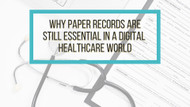Why Paper Records Are Still Essential in a Digital Healthcare World
By Paul Smith, CEO – First Products, Inc. on Oct 10th 2025
Once upon a time, patients checking in for an office visit couldn’t help but notice the rows of shelves full of patient records behind the reception desk. That was the most efficient place to keep them, after all. But paper has been largely phased out of everyday operations. According to the latest statistics from the Office of the National Coordinator for Health IT, 96% of hospitals and 77.8% of office-based physicians in the U.S. have adopted a certified electronic health record (EHR) system. As a result, most providers have digitized and shredded those stacks of files or moved them into storage.

This would give the average healthcare non-expert the impression that paper records have gone the way of floppy disks – obsolete and extinct and this couldn’t be further from the truth.
While the majority of our business is now focused on IT products like mobile carts and mounts to support EMR’s we’ve actually seen demand for paper records, filing systems and related products increase over the last year.
There are a couple of obvious questions here. What value do paper systems bring to healthcare providers in today’s digital age? And why are providers deciding to use paper despite the constant barrage of change across the industry?

There are several reasons:
- Risk Mitigation against Ransomware Attacks and Data Failures. No matter how good tech becomes, there are still glitches from time to time. And when those bugs, downtime events, cyberattacks, etc. happen to providers, they directly cause revenue loss, operational stalls, and patient issues. In our experience, the providers that still integrate paper records are the ones operating the smoothest no matter what any given day brings. They’ve realized that sticking with legacy systems is an essential way to mitigate risk.
- Constants. While tech is more integrated into normal operations every day, there are still items that providers need that aren’t and may never be touched by tech. For example, there are some very specific kinds of paper folders that some organizational systems require. There also are some legacy products like tags that serve functions and fulfill needs that today’s tech cannot deliver on.
- Compliance. There are hundreds if not thousands of new regulations being implemented every year, and it’s only getting harder to stay on top of it all. Despite widespread EHR use, providers still process over 16 billion pages of paper each year. While new digital systems can be incredibly helpful, our clients still find value in having paper around as a tangible fallback to prove due diligence and support compliance.
- Horizontal Integration. Some providers may be integrated with dentists or service providers in other industries that are still required to use paper for some operational purposes. It’s sometimes easier for these organizations to use systems with broader utility than to procure, implement and integrate unique systems across disparate business units.
- Preference. There are still providers out there that have simply kept doing things the way they always have. It’s not necessarily a resistance to change – it’s a strategic decision to not fix what isn’t broken, and to allocate time and resources they might spend on new systems to their own tried-and-true problem-solving and customer service methods. It’s what works for them, and we’re here for it.
It's clear to us: old-school paper records, files and related products aren’t relics from a bygone era after all. In fact, they’re alive and well, and they still represent and enable best practices in a healthcare landscape that continues to evolve. We’ll continue to assist our clients in this area as long as they see the value. In a fast-moving industry, the most resilient providers are those that know true progress doesn’t always mean abandoning old ways; it means knowing how to integrate the best of both worlds.
Paul Smith is the CEO of First Products. For more information about the company and its products, visit www.firstproducts.com.
